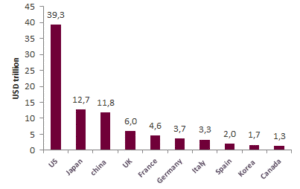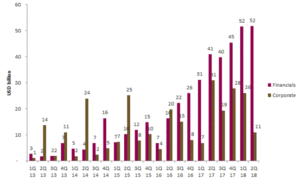An Elephant to Grow Bigger – The size of the Chinese bond market has already reached USD11.8 trillion and became the world’s third largest in 2017 (see chart below) with foreign ownership limited at 5%. Expectations are for the market to continue to grow with Chinese bond issuance set to increase in line with GDP growth. China has a budget deficit target of 2.6% of GDP (3.7% actual in 2017) and will fund this deficit through increased borrowing. GDP growth was 6.8% in Q1 2018 YoY, higher than our forecast of 6.4% YoY for 2018, and a slight deceleration for the rest of the year seems inevitable given the strong headwinds on global trade wars and the higher oil price (China is a net oil importer). What’s more, substantial issuance will be needed to fund the Belt and Road Initiatives at local government and State-owned Enterprise (SOE) levels which generally pay 85% of public expenditures (IMF).
World’s Top 10 Bond Markets by Outstanding Bond Amounts (Q4 2017)

Source: Bank for International Settlements, Indosuez Wealth Management
Improving Market Liquidity to Facilitate Rising Onshore Issuance – Since the launch of Bond Connect* in July 2017, the foreign holdings on the Chinese central government onshore bond started to inch higher from 4% to slightly over 5% today. From April 2019, the Chinese government and policy banks** onshore CNY bonds will enter the Barclays Global Aggregate Index and represent around 5.5% of the index. The inclusion will further enhance the Chinese onshore bonds’ market liquidity as the Barclays index is one of the most widely used benchmarks. (*Bond Connect allows certain foreign investors such as banks, insurance companies, brokerage and asset management firms to invest in Chinese onshore bond market through the Hong Kong Exchange. **Policy banks are China Development Bank, the Export-Import Bank of China, and the Agricultural Bank of China.)
The Offshore Market is Growing in the Same Direction – As overseas private investors still have no access to the onshore market, the offshore market is where we can invest. Its market size of USD 193 billion represents 2% of the total Chinese bond market, but the market is set to expand further. At the sub-national level, the central government granted local governments a 75% higher quota for issuing new debt this year. At the private sector level, the government’s restrictive measures in shadow banking activities since the second half of 2016 have pushed corporates to borrow on the offshore market (see chart below). Financial institutions still favour issuing offshore bonds over onshore bonds to fund their overseas operations.
Chinese Private Sector Offshore USD Bond Market
 Source: Bloomberg, Indosuez Wealth Management
Source: Bloomberg, Indosuez Wealth Management
Should We Worry? The expanding speed of the Chinese bond market can be disconcerting in its own right. Our economist believes that governments can have more debt if they are efficient, but the Chinese central government is clear that it will no longer bail out local government debt issued after 15 January 2015. In this uncertain time, high conviction bond selection on Chinese SOE bonds will demand a thorough analysis on the SOE’s strategic importance to the local government, the economic strength of the local government, the bond structure, and the bond language of any explicit and implicit guarantees. On private sector bonds, new drivers of growth from government initiatives such as ‘Made in China 2025’ include information and communication technology, healthcare, pharmaceutical and biotech sectors. By contrast, traditional drivers of growth such as building materials, energy, and real estate are likely to lose out in the race for higher productivity.





































